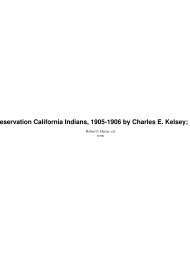Spring 2007 - Yosemite Online
Spring 2007 - Yosemite Online
Spring 2007 - Yosemite Online
- No tags were found...
You also want an ePaper? Increase the reach of your titles
YUMPU automatically turns print PDFs into web optimized ePapers that Google loves.
MOONBOW CONDITIONS1. Clear sky2. Abundant mist and spray at the base of the fallThe best moonbows at <strong>Yosemite</strong> occur during peaksnowmelt runoff, from April to June and sometimesearly July.3. Dark skyThe Sun should be more than 9 degrees below thehorizon, ending bright twilight.4. Bright moonlightThe brightness of the Moon depends on its phase,distance from Earth, and altitude above the horizon.The minimum brightness conditions considered by theprogram correspond to a Moon at an altitude of 25degrees, at its mean distance, and with an illuminatedfraction of 95%.5. Unobstructed moonlightFor moonlight to strike the spray at the base of Lower<strong>Yosemite</strong> Fall, the Moon must be above the nearbymountains, domes, and cliffs.DONALD OLSONJohn Muir, commemorated in this 1964 postage stamp, was anenthusiastic <strong>Yosemite</strong> moonbow observer.6. Correct rainbow geometryThe Lower <strong>Yosemite</strong> Fall viewing area is a paved terraceat the west end of a wooden bridge over <strong>Yosemite</strong>Creek. From here, a moonbow will appear only whenthe angle between the antilunar point and the directiontoward the base of the fall is near the rainbow angle of42 degrees.he could view smaller intermediate falls on the plateaubetween Upper and Lower <strong>Yosemite</strong> Falls:…the moonbeams were pouring through…I saw a welldefinedspray-bow, beautifully distinct in colors…whilepure white foam-waves beneath the beautiful bow wereconstantly springing up out of the dark into the moonlightlike dancing ghosts.By the time he published this book, Muir had beenobserving moonbows for more than four decades. In anApril 1871 letter to Mrs. Jeanne S. Carr, he wrote:Silver from the moon illumines this glorious creationwhich we term “falls,” and has laid a magnificent doubleprismatic bow at its base. The tissue of the fall is delicatelyfilmed on the outside like the substance of spentclouds, and the stars shine dimly through it.COMPUTING MOONBOW VISIBILITYInspired by Muir’s dramatic accounts, we decided to writea computer program to predict the dates and times whenmoonbows should appear. Six conditions are requiredfor a moonbow to be readily visible. The first two areweather-dependent, but the remainder require astronomicalconditions that can be modeled by computer. Ourprogram forecasts optimal moonbow viewing times forthe area near the base of Lower <strong>Yosemite</strong> Fall.TRIP TO YOSEMITEAscertaining the profile of the local horizon and the geometryof the viewing area relative to the falls required a visitto the site. Fortunately, our research group had alreadyscheduled a trip to<strong>Yosemite</strong>. In an article in Sky & Telescopemagazine, we predicted that on September 15, 2005, theMoon’s position would recreate the scene in AutumnMoon, a famous Ansel Adams photograph from GlacierPoint. The moonrise event was a great success, withhundreds of photographers in attendance, but we spentmost of our time in the park near Lower <strong>Yosemite</strong> Fall.That September, the flow of water was little morethan a trickle. This worked to our advantage. Wecould stand right at the base of the fall, somethingthat would be impossible in the thundering torrentsof the spring runoff season. We took night photographsof the nearby mountains and cliffs silhouetted4 YOSEMITE ASSOCIATION, SPRING <strong>2007</strong>




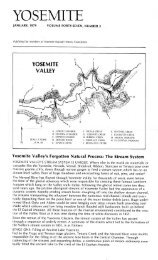
![(March 1982) [PDF] “We Are Pleased to Announce†- Yosemite Online](https://img.yumpu.com/51299748/1/190x242/march-1982-pdf-aeuroewe-are-pleased-to-announceaeur-yosemite-online.jpg?quality=85)
![[PDF] Old Horny, Yosemite's Unicorn Buck - Yosemite Online](https://img.yumpu.com/51269869/1/184x260/pdf-old-horny-yosemites-unicorn-buck-yosemite-online.jpg?quality=85)
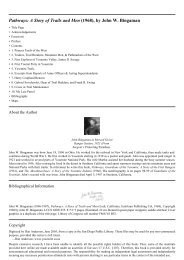
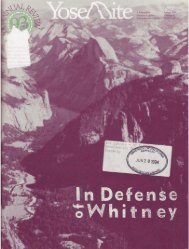
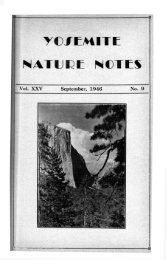
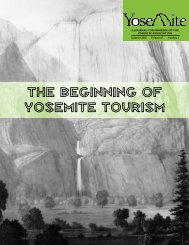
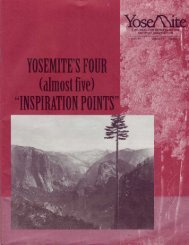
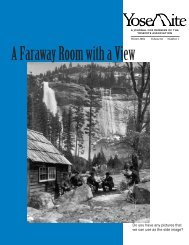
![1985 [PDF] - Yosemite](https://img.yumpu.com/48128837/1/184x260/1985-pdf-yosemite.jpg?quality=85)
